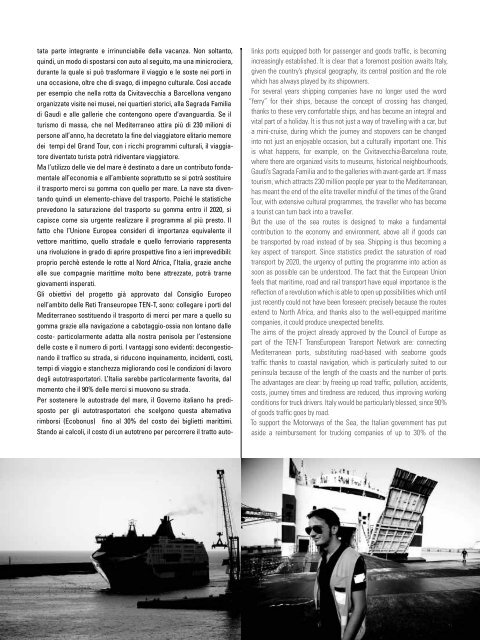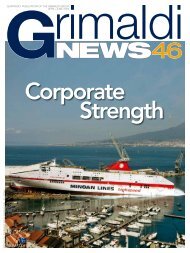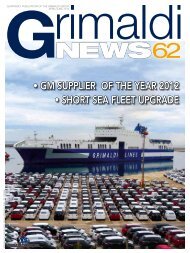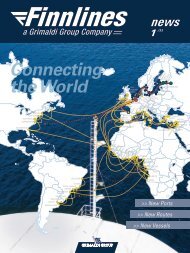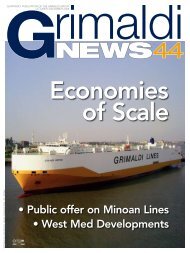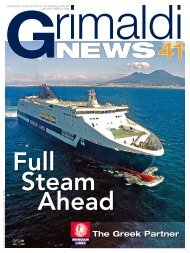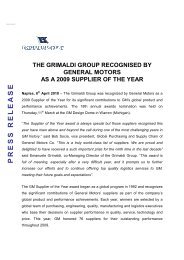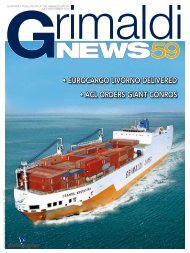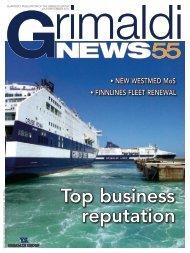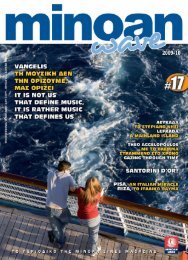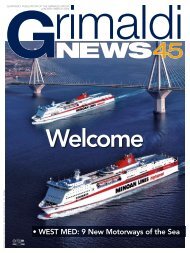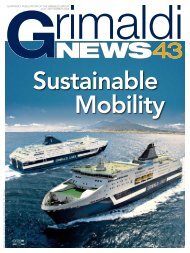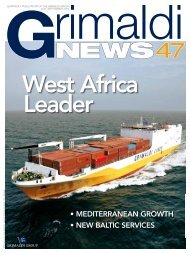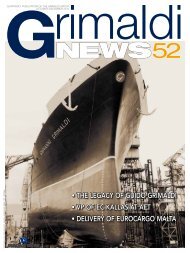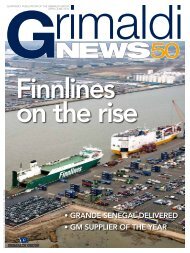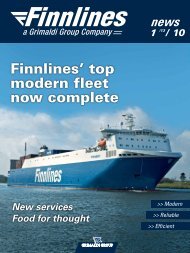umenitsa - Patras - Grimaldi Group
umenitsa - Patras - Grimaldi Group
umenitsa - Patras - Grimaldi Group
Create successful ePaper yourself
Turn your PDF publications into a flip-book with our unique Google optimized e-Paper software.
tata parte integrante e irrinunciabile della vacanza. Non soltanto,<br />
quindi, un modo di spostarsi con auto al seguito, ma una minicrociera,<br />
durante la quale si può trasformare il viaggio e le soste nei porti in<br />
una occasione, oltre che di svago, di impegno culturale. Così accade<br />
per esempio che nella rotta da Civitavecchia a Barcellona vengano<br />
organizzate visite nei musei, nei quartieri storici, alla Sagrada Familia<br />
di Gaudì e alle gallerie che contengono opere d’avanguardia. Se il<br />
turismo di massa, che nel Mediterraneo attira più di 230 milioni di<br />
persone all’anno, ha decretato la fine del viaggiatore elitario memore<br />
dei tempi del Grand Tour, con i ricchi programmi culturali, il viaggiatore<br />
diventato turista potrà ridiventare viaggiatore.<br />
Ma l’utilizzo delle vie del mare è destinato a dare un contributo fondamentale<br />
all’economia e all’ambiente soprattutto se si potrà sostituire<br />
il trasporto merci su gomma con quello per mare. La nave sta diventando<br />
quindi un elemento-chiave del trasporto. Poiché le statistiche<br />
prevedono la saturazione del trasporto su gomma entro il 2020, si<br />
capisce come sia urgente realizzare il programma al più presto. Il<br />
fatto che l’Unione Europea consideri di importanza equivalente il<br />
vettore marittimo, quello stradale e quello ferroviario rappresenta<br />
una rivoluzione in grado di aprire prospettive fino a ieri imprevedibili:<br />
proprio perchè estende le rotte al Nord Africa, l’Italia, grazie anche<br />
alle sue compagnie marittime molto bene attrezzate, potrà trarne<br />
giovamenti insperati.<br />
Gli obiettivi del progetto già approvato dal Consiglio Europeo<br />
nell’ambito delle Reti Transeuropee TEN-T, sono: collegare i porti del<br />
Mediterraneo sostituendo il trasporto di merci per mare a quello su<br />
gomma grazie alla navigazione a cabotaggio-ossia non lontano dalle<br />
coste- particolarmente adatta alla nostra penisola per l’estensione<br />
delle coste e il numero di porti. I vantaggi sono evidenti: decongestionando<br />
il traffico su strada, si riducono inquinamento, incidenti, costi,<br />
tempi di viaggio e stanchezza migliorando così le condizioni di lavoro<br />
degli autotrasportatori. L’Italia sarebbe particolarmente favorita, dal<br />
momento che il 90% delle merci si muovono su strada.<br />
Per sostenere le autostrade del mare, il Governo italiano ha predisposto<br />
per gli autotrasportatori che scelgono questa alternativa<br />
rimborsi (Ecobonus) fino al 30% del costo dei biglietti marittimi.<br />
Stando ai calcoli, il costo di un autotreno per percorrere il tratto auto-<br />
links ports equipped both for passenger and goods traffic, is becoming<br />
increasingly established. It is clear that a foremost position awaits Italy,<br />
given the country’s physical geography, its central position and the role<br />
which has always played by its shipowners.<br />
For several years shipping companies have no longer used the word<br />
“ferry” for their ships, because the concept of crossing has changed,<br />
thanks to these very comfortable ships, and has become an integral and<br />
vital part of a holiday. It is thus not just a way of travelling with a car, but<br />
a mini-cruise, during which the journey and stopovers can be changed<br />
into not just an enjoyable occasion, but a culturally important one. This<br />
is what happens, for example, on the Civitavecchia-Barcelona route,<br />
where there are organized visits to museums, historical neighbourhoods,<br />
Gaudì’s Sagrada Familia and to the galleries with avant-garde art. If mass<br />
tourism, which attracts 230 million people per year to the Mediterranean,<br />
has meant the end of the elite traveller mindful of the times of the Grand<br />
Tour, with extensive cultural programmes, the traveller who has become<br />
a tourist can turn back into a traveller.<br />
But the use of the sea routes is designed to make a fundamental<br />
contribution to the economy and environment, above all if goods can<br />
be transported by road instead of by sea. Shipping is thus becoming a<br />
key aspect of transport. Since statistics predict the saturation of road<br />
transport by 2020, the urgency of putting the programme into action as<br />
soon as possible can be understood. The fact that the European Union<br />
feels that maritime, road and rail transport have equal importance is the<br />
reflection of a revolution which is able to open up possibilities which until<br />
just recently could not have been foreseen: precisely because the routes<br />
extend to North Africa, and thanks also to the well-equipped maritime<br />
companies, it could produce unexpected benefits.<br />
The aims of the project already approved by the Council of Europe as<br />
part of the TEN-T TransEuropean Transport Network are: connecting<br />
Mediterranean ports, substituting road-based with seaborne goods<br />
traffic thanks to coastal navigation, which is particularly suited to our<br />
peninsula because of the length of the coasts and the number of ports.<br />
The advantages are clear: by freeing up road traffic, pollution, accidents,<br />
costs, journey times and tiredness are reduced, thus improving working<br />
conditions for truck drivers. Italy would be particularly blessed, since 90%<br />
of goods traffic goes by road.<br />
To support the Motorways of the Sea, the Italian government has put<br />
aside a reimbursement for trucking companies of up to 30% of the<br />
marenostrum<br />
19


